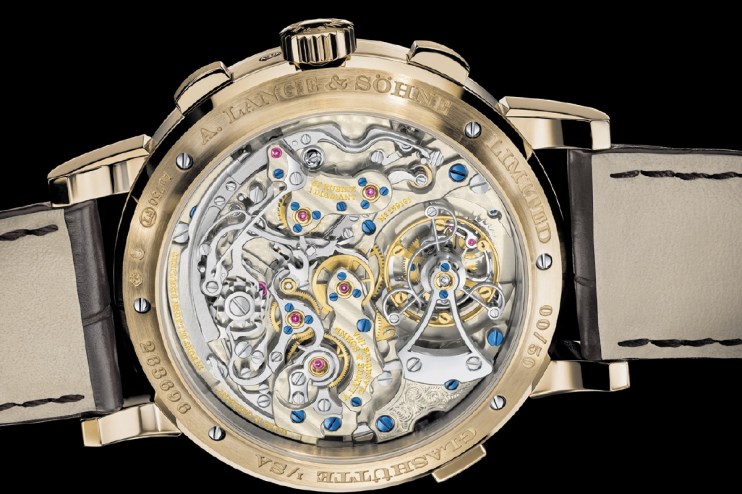
From Abraham-Louis Breguet’s first prototype in 1795 to the 1980s, watch experts reckon less than 1,000 ‘tourbillon’ watches were made. Today that figure is more like 3,000 to 3,500 per year. And the spectrum couldn’t be broader, from a Chinese Sea-Gull for £3,260 to a starting price of €300,000 at Greubel Forsey – then onward and upward if this year’s display of horological fireworks unveiled at Geneva’s Watches & Wonders show are anything to go by.
Meaning ‘whirlwind’ in French, the tourbillon is a whirring merry-go-round in miniature. The tourbillon’s visual fascination is nigh-on hypnotic and it maintains its unyielding grip on the highest echelons of watchmaking. Even the world-weariest of watch cognoscenti can’t help but be deflated by the sight of a lifeless specimen in a Bond Street window, unwound and unanimated.
While the stopwatch chronograph or always-correct perpetual calendar are genuinely handy when boiling an egg or checking the date towards the end of February, and even a chiming ‘minute repeater’ comes in handy during a black-out, the whirling-dervish tourbillon carriage serves little-to-no purpose in a wristwatch.
But this certainly wasn’t the case from the start. When ‘forefather of modern watchmaking’ Breguet patented his invention in 1801 it wasn’t to show off his virtuoso watchmaking skills – it was to address a genuine problem plaguing pocket watches at the time: being upright in one’s waistcoat for the majority of the day.
By tumbling the whole ticking escapement by 360º every minute within a carriage powered by the normal geartrain, the friction was spread evenly around the pendulous balance wheel’s axial pin. So if nowadays pointless in wristwatch format – oriented every which way, all day – why the unflagging fascination, let alone the astronomical pricetags?
“Looking at their contribution to improved timekeeping, I would say that there is no advantage,” says the Isle of Man’s horloger non-pareil Roger Smith, whose own tourbillon pocket watch convinced Dr George Daniels to take him on as his only apprentice back in the 1990s.
“Having said that,” Smith concedes, more romantically, “tourbillon making is very satisfying. Housing a fine escapement into a tiny lightweight cage which then has to continually accelerate and decelerate without affecting the performance of the escapement is an enjoyable challenge.
“Tourbillons will always have a part to play in high-end watchmaking thanks to their mesmerising qualities and ability to showcase their maker’s skills to the wider world.”
Throw in some cylindrical balance springs, spectral skeleton dials, haunting luminescence and aforementioned perpetual calendars, and 2024 appears to be welcoming back some pre-2008 bombast from beyond the Jura mountains…
From Abraham-Louis Breguet’s first prototype in 1795 to the 1980s, watch experts reckon less than 1,000 ‘tourbillon’ watches were made. Today that figure is more like 3,000 to 3,500 per year. And the spectrum couldn’t be broader, from a Chinese Sea-Gull for £3,260 to a starting price of €300,000 at Greubel Forsey – then onward and upward if this year’s display of horological fireworks unveiled at Geneva’s Watches & Wonders show are anything to go by.
Meaning ‘whirlwind’ in French, the tourbillon is a whirring merry-go-round in miniature. The tourbillon’s visual fascination is nigh-on hypnotic and it maintains its unyielding grip on the highest echelons of watchmaking. Even the world-weariest of watch cognoscenti can’t help but be deflated by the sight of a lifeless specimen in a Bond Street window, unwound and unanimated.
While the stopwatch chronograph or always-correct perpetual calendar are genuinely handy when boiling an egg or checking the date towards the end of February, and even a chiming ‘minute repeater’ comes in handy during a black-out, the whirling-dervish tourbillon carriage serves little-to-no purpose in a wristwatch.
But this certainly wasn’t the case from the start. When ‘forefather of modern watchmaking’ Breguet patented his invention in 1801 it wasn’t to show off his virtuoso watchmaking skills – it was to address a genuine problem plaguing pocket watches at the time: being upright in one’s waistcoat for the majority of the day.
By tumbling the whole ticking escapement by 360º every minute within a carriage powered by the normal geartrain, the friction was spread evenly around the pendulous balance wheel’s axial pin. So if nowadays pointless in wristwatch format – oriented every which way, all day – why the unflagging fascination, let alone the astronomical pricetags?
“Looking at their contribution to improved timekeeping, I would say that there is no advantage,” says the Isle of Man’s horloger non-pareil Roger Smith, whose own tourbillon pocket watch convinced Dr George Daniels to take him on as his only apprentice back in the 1990s.
“Having said that,” Smith concedes, more romantically, “tourbillon making is very satisfying. Housing a fine escapement into a tiny lightweight cage which then has to continually accelerate and decelerate without affecting the performance of the escapement is an enjoyable challenge.
“Tourbillons will always have a part to play in high-end watchmaking thanks to their mesmerising qualities and ability to showcase their maker’s skills to the wider world.”
Throw in some cylindrical balance springs, spectral skeleton dials, haunting luminescence and aforementioned perpetual calendars, and 2024 appears to be welcoming back some pre-2008 bombast from beyond the Jura mountains…